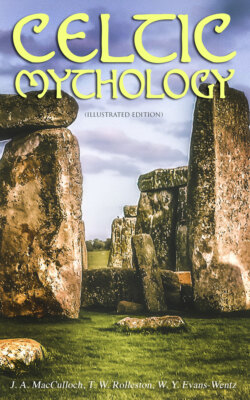Читать книгу CELTIC MYTHOLOGY (Illustrated Edition) - T. W. Rolleston - Страница 34
The Celts of the Plains
ОглавлениеDe Jubainville, in his account of the early history of the Celts, takes account of two main groups only—the Celts and the Megalithic People. But A. Bertrand, in his very valuable work “La Religion des Gaulois,” distinguishes two elements among the Celts themselves. There are, besides the Megalithic People, the two groups of lowland Celts and mountain Celts. The lowland Celts, according to his view, started from the Danube and entered Gaul probably about 1200 B.C. They were the founders of the lake-dwellings in Switzerland, in the Danube valley, and in Ireland. They knew the use of metals, and worked in gold, in tin, in bronze, and towards the end of their period in iron. Unlike the Megalithic People, they spoke a Celtic tongue,4 though Bertrand seems to doubt their genuine racial affinity with the true Celts. They were perhaps Celticised rather than actually Celtic. They were not warlike; a quiet folk of herdsmen, tillers, and artificers. They did not bury, but burned their dead. At a great settlement of theirs, Golasecca, in Cisalpine Gaul, 6000 interments were found. In each case the body had been burned; there was not a single burial without previous burning.
This people entered Gaul not (according to Bertrand), for the most part, as conquerors, but by gradual infiltration, occupying vacant spaces wherever they found them along the valleys and plains. They came by the passes of the Alps, and their starting-point was the country of the Upper Danube, which Herodotus says “rises among the Celts.” They blended peacefully with the Megalithic People among whom they settled, and did not evolve any of those advanced political institutions which are only nursed in war, but probably they contributed powerfully to the development of the Druidical system of religion and to the bardic poetry.
